Drawings that may seem complicated at first glance are images of animals living in the wild. To make the image naturalistic, the author must correctly display the proportions and accurately draw many details. Step-by-step execution of the work will make drawing easy and attractive for children. Using pencils, the young artist will be able to capture the chosen character step by step - for example, a lynx.
General rules for drawing an animal
Lynx (the drawing for children is suggested to be simplified a little in details) is a big cat, a mysterious master of the forest wilderness. The predator has fluffy ear tufts, long large paws, a compact body, a short tail. When drawing, it is important not to forget about these differences from other wild representatives of the cat family.
First, it is important for the child to learn to proportionally depict an animal, drawing the details of the muzzle, body, and limbs. Then the resulting image on paper is supplemented with a characteristic landscape or details.
The operating algorithm is as follows:
- The character's place on the plane of the sheet is determined compositionally.
- Outline ovals for the head and body.
- The elements of the head are drawn step by step, starting with the nose.
- The construction of body parts is correlated with the size of the paws and head.
- At the very end, add stripes on the tail, whiskers, ear tufts, and fur color lines.
- They paint the lynx's fur, eyes, and nose.
- They begin to detail the surrounding landscape.
- The drawing is completed by outlining the foreground elements, accentuating the eyes, nose, and tassels on the ears.
When depicting any living creature, the author involuntarily endows it with a character, some distinctive property. To successfully draw animals, information is needed about some elementary features of the character, its habits, habitats.
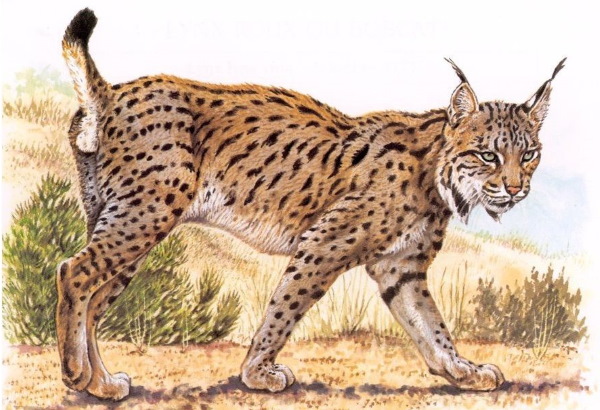
The lynx is called a "forest shadow" in literary works. The young artist will be interested to learn more about the life of this unusual predator.
Therefore, at the beginning of the lesson, the following facts about lynxes are studied together with the children:
- the animal lives in coniferous forests and rocky areas;
- the body is up to 1.3 m long, weight from 14 to 40 kg;
- The big cat has elongated paws, at the ends of which are hidden sharp claws - the main weapon of the animal, in addition to teeth;
- lies in wait for prey, sitting in ambush for a long time on tree branches, in small gorges among rocks;
- The lynx has long tufts on its ears, a lush fur collar and sideburns on its muzzle;
- The fur on the chest and belly is white.
Simple pencil drawing
Lynx (a drawing for children is a step-by-step image of the character) is recommended to start drawing from the central element of the muzzle - the nose. Using auxiliary axes and ovals, build the body, head, paws.
What tools will you need?
The following set of materials is used:
- a simple pencil with a soft or hard-soft lead;
- eraser;
- a sheet of thick paper.
How to draw
Place A4 paper horizontally and then draw following the detailed description of the work.
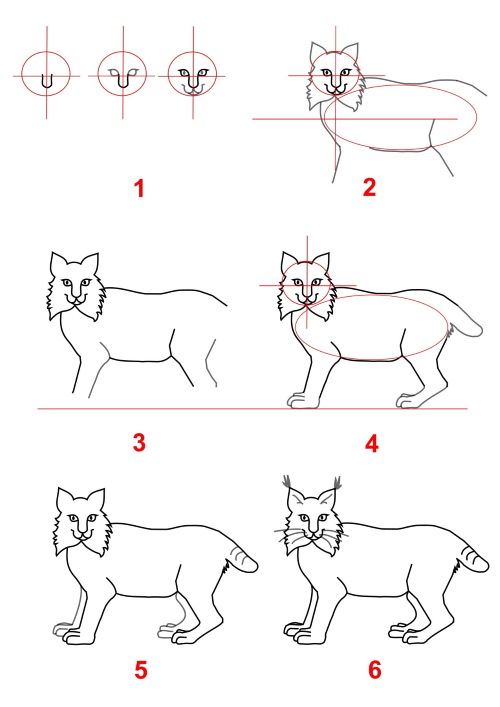
The illustration shows more general stages of drawing:
| Stage | Description |
| 1 | A little to the left of the center of the sheet, mark a small circle, divide it into 4 parts with thin lines. In the middle, in the lower half of the circle, outline the lynx's nose. |
| 2 | In the upper part of the circle, starting from the ends of the nasal lines, draw the contours of the eyes symmetrically. |
| 3 | From the center of the lower part of the nose, the parts of the forked upper lip and the chin are depicted in semicircles. In the center of the eyes are elongated, pointed pupils. |
| 4 | They outline a rounded head, adding symmetrical ears, fluffy sideburns on the sides in the form of triangles with notches. At the bottom, the sideburn lines converge into the lower central point of the chin. |
| 5 | To the right and below the circle of the head, draw an auxiliary elongated oval to construct the body. The axis divides it in half. |
| 6 | From a point on the lower sideburn line, draw a curved line depicting the chest and the beginning of the front leg. The back is drawn with 2 connected convex lines, starting from a point on the side of the head. The line of the lower abdomen runs straight along the border of the auxiliary oval. The animal's thigh is outlined on the right side of the body, starting from the axial line of the oval. |
| 7 | Starting from the end point of the back, draw a small rounded tail. Continue the contours of the front and back paws, making them approximately the same thickness. At the bottom of each paw, depict three fingers, tightly pressed against each other. To make the figure look stable, the soles are placed at the same level. |
| 8 | Outline the paws located in the background, almost copying the contours of those drawn earlier. On the tail, add transverse strokes of color. |
How to complete a drawing
On the muzzle, draw long whiskers with slightly rounded lines, extending beyond the sideburns. The ears are complemented with symmetrical outlines of the inner contour, long fluffy tassels. All auxiliary geometric figures and lines are removed with an eraser. The image of a lynx in a simple pencil is complete. Then the child can color the resulting character.
With colored pencils
Lynx fur can be brown-gray, golden, red, bluish-ash shade. Small dark spots are "scattered" over the body - such coloring helps the predator to remain indistinguishable in the thicket of trees, rocky gorges. For their drawings, children choose any option for coloring the animal's fur that they like.
What tools will you need?
The child should have the following items prepared:
- a thick sheet of paper for pencil sketches;
- eraser;
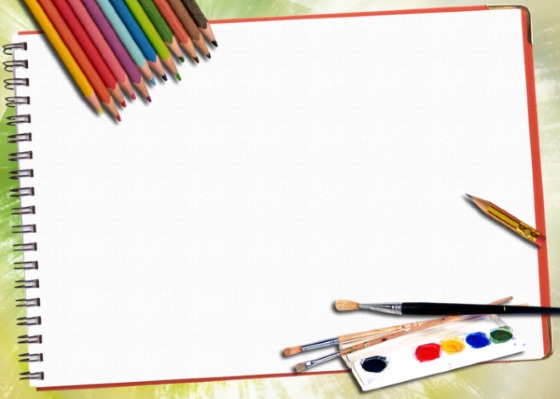
- a simple pencil for an outline sketch of the character;
- a set of colored soft pencils or crayons.
How to draw
The illustrations show approximate color schemes for the animal's image. The young author's attention is drawn to the different shades of fur, the particular combination of spots on the fur. It is important to note that the spotting is not distributed over the body in a chaotic manner - the spots are located as if on invisible longitudinal lines running along the body, paws, head, tail.
Together with the child, select colors for painting the eyes and nose. The strokes are applied, trying to convey the texture of the predator's fur - the movements of the pencil should be small, because the lynx has a fairly short fur pile. This technique will increase the naturalism of the work.
The sheet of paper is placed horizontally on the table, determining the center of the composition. When using a 12-color set, a light brown tone is achieved by applying light pressure on the brown lead. The ochre is replaced by a soft orange shading, weakening it on the white fur areas. The table describes the stages of the work in detail.
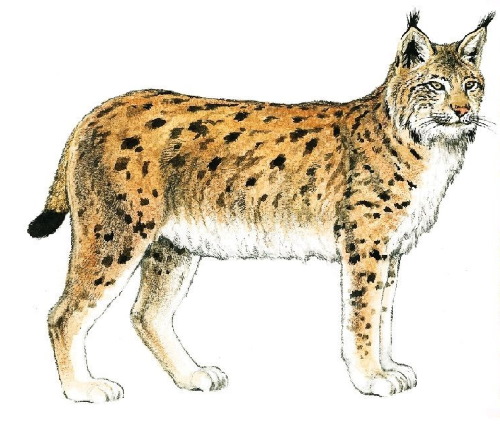
| Stage | Description |
| 1 | On paper, draw a circle with transverse axes inside. Depict the head of the animal. |
| 2 | Following the shape of the auxiliary oval and axes, draw the contours of the body and paws. |
| 3 | Outline the tail, soles, and small details of the head. |
| 4 | Unnecessary geometric constructions are removed with an eraser. |
| 5 | Use a sharp yellow pencil to outline the pupils, then color the remaining area of the iris with green. |
| 6 | The nose is painted powder pink or light orange. |
| 7 | Using a light brown pencil, finely shade the head, except for the area around the nose, sideburns, and the inner surfaces of the ears. |
| 8 | The body is shaded with the same color, applying short strokes lengthwise, towards the tail. The lynx's belly is not colored. |
| 9 | A light brown pencil is used for shading the paws and tail. The pencil is moved vertically over the sheet, in small movements, following the direction of the pile on the limbs. |
| 10 | Using an ochre pencil, paint over:
|
| 11 | With a dark brown pencil, outline small round spots on the forehead, upper part of the paws, and the end of the tail. |
| 12 | The spots on the sides and under the eyes are made longitudinal, arranged in broken stripes. |
| 13 | The same color is used to shade the sideburns, shade the tassels on the ears, and accentuate the outline of the eyes, lengthening their slanted shape with color. |
| 14 | Brown is used to refine the contour of the nose, the outline of the split upper lip, and the chin. |
| 15 | At the bottom of the paws, draw the outline of the toes and soles with small strokes. |
| 17 | The drawing is given volume by carefully applying dark brown shading to the paws located in the background (in natural shadow). |
How to complete a drawing
The white fur areas are shaded with grey-brown shading, leaving the illuminated fur white (uncolored). The whiskers, outline of the head elements, and ear tufts are worked out with a black pencil. The color spots located in the shaded areas of the body are additionally lightly shaded with a black pencil.
In the final stage of the work, you can use a thin black or dark brown marker to accentuate the contours of the entire figure of the predator, the soles, eyes, and nose.
Lynx on a tree branch
The lynx (the drawing for children can be a little more complicated) is often depicted lying on a tree branch. This is one of the natural positions of the predator.
To capture the image of a lynx, you need to carefully build the proportions of the animal's figure on paper. You will need to draw auxiliary ovals, axes, and observe the proportions of the masses of the body, paws, and head.
What tools will you need?
For this lesson you will need:
- thick A4 paper;
- eraser;
- pencil with a simple lead, hard-soft;
- colored crayons or pencils.
How to draw
The position of the animal lying on a tree branch requires horizontal orientation of the paper sheet. The compositional fields of the drawing must be determined. For geometric constructions of auxiliary elements, you can use a template, compass, or outline suitable rounded objects. The table provides detailed information about all the steps of drawing.
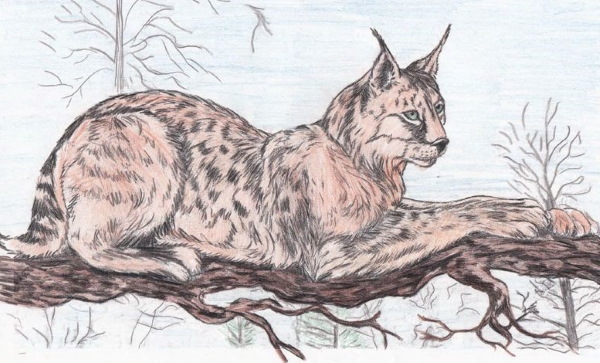
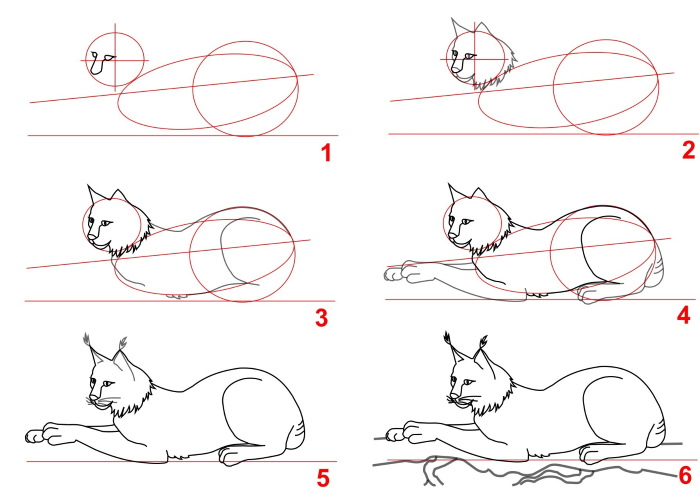
| Stage | Description |
| 1 | In the lower third of the sheet, a thin horizontal line is drawn; it serves as a guide for the position of the paws. |
| 2 | Above it, stepping back, outline a small circle, determine the transverse axes. Next to it, slightly lower, depict an oval touching it. |
| 3 | In the lower left part of the circle, draw a wedge-shaped contour of the nose. On both sides of the nose line in the upper quarter of the circle, draw slightly slanted rounded eyes. |
| 4 | On both sides of the vertical axis of the head, draw the ears in the form of a triangular outline. Draw a short line to indicate the nose. Form the chin and upper lip from 3 convex lines. Add vertical pupils. Complete the outline of the head with a zigzag line depicting fluffy sideburns. |
| 5 | On the right side of the long auxiliary oval, another circle is outlined. Using geometric constructions as a guide, the back, stomach, chest, and rounded hip are outlined with curved lines. |
| 6 | Through the oval, which helps to understand the position of the body, draw a longitudinal axis slightly above its geometric center. Draw the front paw, with its upper edge touching this axis. The lower point of the elbow of the front paw and the sole of the back paw are on the same line. |
| 7 | The rounded back is completed by outlining the tail. The toes are drawn at the ends of the paws. |
| 8 | Thin lines of axes, ovals, and circles are erased with an eraser. |
| 9 | The head is complemented by the following elements:
|
| 10 | A broken line is used to draw the outline of the tree branch on which the predator lies. |
| 11 | The irises of the eyes are painted yellow-green, and the nose is painted pink-orange. |
| 12 | The predator's body is shaded with a combination of light brown and reddish shades. |
| 13 | The tone is darkened at the bottom of the abdomen, at the bottom of the neck and at the bends of the limbs. |
| 14 | Using dark brown contour shading, work on the areas inside the ears, around the eyes, tassels, shadow on the nose, and chin. |
| 15 | The same color is used to draw the spotted coloring of the fur. |
| 18 | The tree bark is painted in a reddish-brown tone, with black veins added. |
| 19 | White chalk is used to lighten areas of fur on the animal’s face, thighs, and upper surface of the paws. |
| 16 | In the background, a light sketch of other trees is made with grey and light green pencils. |
| 17 | The sky is painted with long, even strokes of light blue. |
How to complete a drawing
To make the work look complete, a sharp black pencil is used to accentuate the contour of the eyes, head details, and ear tufts. Fine shading is used to add texture to the animal's fur, and to outline the curves of the tree branch. The background is left vaguely drawn - then the drawing will have a sense of space and volume in the composition.
Lynx in the forest
A lynx (a drawing for children is created based on photographs of the animal) can be captured in the wild, in the forest, in a rocky area. To successfully draw the position of a walking predator, you again need to painstakingly build the proportions of the body, observe the ratio of the main elements of the body, head, limbs.
What tools will you need?
For work, prepare the following set of items:
- thick A4 paper sheet;
- eraser;
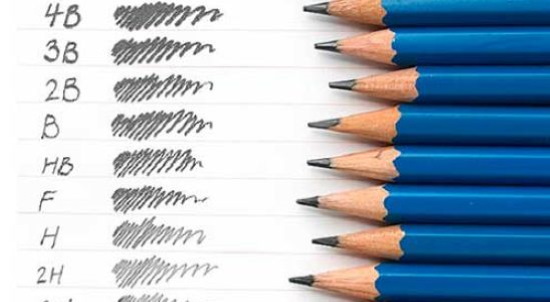
- a simple lead pencil marked B or HB;
- a set of colored crayons, pastels, pencils with soft leads.
An interesting version of the drawing will be obtained if you choose thick craft paper of a light brown color. The shade of the paper sheet will serve as the background of the composition. This type of paper is specially designed for working with different types of pencils. With wide strokes of colored chalk on a craft sheet, you can advantageously depict coniferous trees, foliage, rocks.
How to draw
The lynx figure occupies the central position in the composition. The sheet can be laid out on the table vertically or horizontally, as desired. First, it is necessary to perform auxiliary geometric constructions. The outline of the animal is outlined gradually, correlating it with the lines of circles, ovals, and axes.
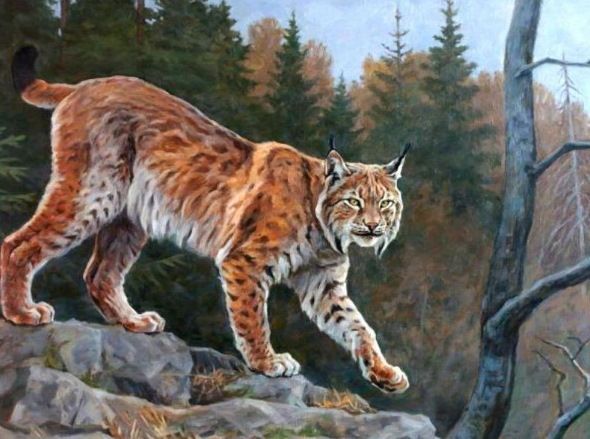
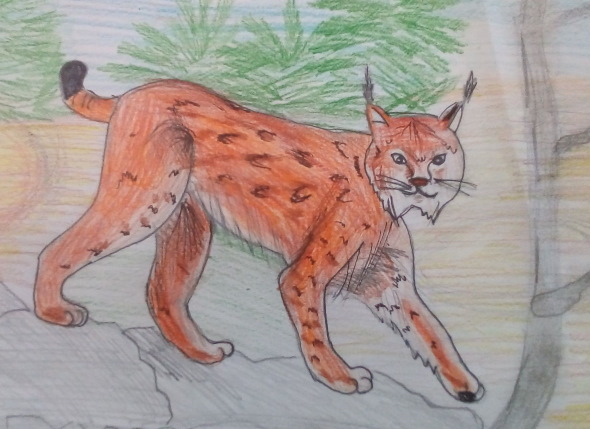
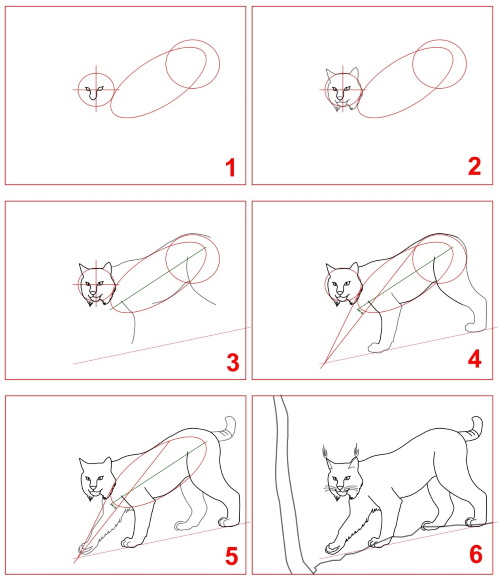
This composition may be difficult for children of primary school age, since the lynx is depicted with its left paw extended forward. The limb is raised, slightly turned towards the viewer. The entire figure of the predator is tilted forward, located at a slight angle.
The first color illustration shows an example of a lynx image, made in detail from a photograph. The second one shows a child's drawing, close to the example. In order to successfully complete the work, you need the skill of constructing the animal's body. It makes sense to practice in advance on separate sheets of paper to depict a standing, lying lynx.
The table shows the characteristics of the main stages of drawing.
| Stage | Description |
| 1 | A little to the left of the center of the sheet, draw a small circle with transverse axes. At an angle to it on the right, place an elongated oval, approximately 2 times larger in mass. At the end of the oval, draw another circle, larger than the first. |
| 2 | In the lower left part of the 1st circle, mark the nose (with a wedge-shaped curved line), and draw the eyes from the extreme points. |
| 3 | The remaining elements of the head, nose, and ears are drawn. The outline of the head is completed with fluffy sideburns. |
| 4 | From the middle point of the right ear, draw a wavy line to the oval, continue it, going around the second circle. Following the opposite side of the oval, outline the lynx's belly. |
| 5 | Under the right sideburn, from a point on the longitudinal axis of the oval, begin to draw the front paw. Almost from the center of the 2nd circle, draw the thigh with a convex line. |
| 6 | Finish drawing the body, front and back legs, making them approximately equal in thickness. |
| 7 | Stepping down from the intersection point of the axis (shown in green in the illustration) and the outline of the oval, place a point. Connect it with a long straight line to the point of contact between the large circle and the oval. Continue this straight line until it intersects with the inclined axis on which the animal's soles stand. Connect the intersection point to the point of contact between the small circle and the oval. |
| 8 | The resulting acute angle of 2 straight lines is a guide for constructing the left paw, stretched forward. It is drawn starting from a point on the right sideburn, and is completed with a zigzag contour to the right paw. |
| 9 | At the back, draw the second hind limb, a short tail, bent upwards. The sole of the second hind paw is placed slightly above the auxiliary inclined axis. |
| 10 | They detail the animal's head, drawing tassels on the ears and whiskers. They depict a rock and the trunk of a tree growing on the left with broken connected segments. |
| 11 | Carefully erase the auxiliary geometric figures and straight lines with an eraser. |
| 12 | Behind the figure of the predator, a sketch of a forest landscape is made, and in the foreground, stones and grass are drawn. |
| 13 | The back, sides, and tail of the lynx are shaded with bright orange. |
| 14 | The same pencil is used to paint the head, leaving the ears, sideburns and the area around the eyes and nose white. |
| 15 | The paws are partially filled with orange shading. |
| 16 | Using a bright brown pencil, make spots on the fur, placing them longitudinally along the body and limbs. |
| 17 | The eyes are painted light green, and the nose dark pink. |
| 18 | Pale gray partially shades the texture of the fur on the stomach, thigh, chest, and outstretched paw. |
| 19 | Light brown shading gives volume to the white fur. |
| 20 | The tip of the tail and the spots on the fur located on the paws and at the bottom of the head are further darkened with a brown-black tone. |
| 21 | Using a dark pencil, more clearly outline the toes, soles, and pads on the outstretched paw. |
| 22 | The edging on the ears, tassels, eye outlines, and pupils are made in black. |
| 23 | The line of the nostrils, mouth, and moustache are accentuated with a pencil outline. The ends of the sideburns are darkened. |
| 24 | Using unidirectional hatching, apply shadow to the chest and the inner surface of the hind leg. Give shape to the thigh. |
| 25 | The withers area, top of the head, toes, and tail are highlighted with bright light orange chalk. |
| 26 | Shades of gray are used to densely paint over the rocky stones, and blue-gray is used for the tree trunk. Black and dark brown pencils are used for shadows. |
| 27 | The trees and conifers in the background are painted in dark green and brown tones. The sky is shaded in blue. |
How to complete a drawing
A bright drawing can be made more graphic by using a black gel pen. An example of such an outline is shown in the second color illustration. The elements of the head located in the foreground, the pupils, the soles and pads of the paws are carefully outlined. A thin outline is applied moderately to the entire figure of the animal. At the bottom of the rocks, autumn grass is drawn in pale orange shading.
For children, compositions with different positions of the lynx's body may be difficult. It is always worth starting with simple drawings. Step-by-step construction of the animal's figure, correlation of image details with geometric elements and axes will help the young artist in creating extraordinary creative works.
Video about drawing
Lynx drawing for kids:
